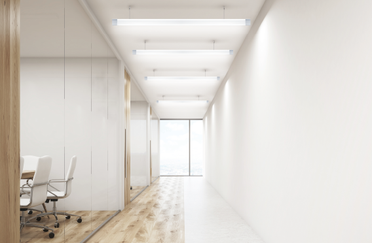The 5 big trends in office lighting
 | Offices, and the way we work in them, are changing for good. Lighting has to change too. From flexible working to personalised control, the need to save energy, and putting people at the heart of lighting design, the prioirities and practices of office lighting are in flux. Here's what you need to know. |
#1 FLEXIBILITY
The days when office workers simply sat at the same desk all day are gone. Open-plan offices have long been the norm, and more and more office workers now work flexible hours, meaning more hot-desking and remote working using mobile devices. As a result, many offices now place
an increasing emphasis on online and face-to-face meetings and conversations. Even workers who are mainly desk-based may be using portable
devices, and may not be at the same desk from day to day. Laptops, tablets and phones with backlit screens are everywhere in the modern office, so glare that could make these difficult to use must be avoided.
#2 SAVING ENERGY
Saving energy is one of the key ways lighting can add value for owners and operators of ofices. By spending a little more upfront, users can make big savings in the long run. The good news is, it’s easier than ever to save energy in offices with lighting. Most offices have been using energy-efficient T5 fluorescent lighting for years, so LED lighting has been slower to catch on in offices than in some other applications.
But now the efficacy of LED lightingis such that LEDs are replacing fluorescent in offices, and smart controls are getting energy consumption
even lower.
#3 CONTROL
Lighting controls are getting more sophisticated – but easier to use – by the day, helping offices to create a positive atmosphere while making
significant savings on energy. Giving workers more control over their light has been shown to increase job satisfaction, and controls can prevent
light being wasted in areas near windows, or in places that are not always in use, such as meeting rooms, corridors and toilets. Many of today’s
control systems are wireless, making it easy for staff to control them from mobile devices or handheld controllers, and making installation and commissioning much simpler, because no new wiring is required.
#4 LIGHT FOR PEOPLE
The most important assets within an office are the people, and in recent years it has become more and more clear that lighting has a big effect
on people’s wellbeing, alertness and productivity at work. In the past, lighting standards have sometimes focused on how we light tasks, such as reading or looking at computer screens, at the expense of how light affects people. To strike the right balance, we need to light not just the task, but also the space and the face, so people can feel comfortable and communicate
#5 MAKING THE MOST OF DAYLIGHT
Offices are increasingly seeking to maximise the amount of natural light they benefit from. People like having access to daylight in offices, and it has been shown to be good for us. It’s also free. This presents an opportunity to get energy costs down by dimming lights or turning them off when there is sufficient natural light available. To achieve it, you’ll need good controls.
